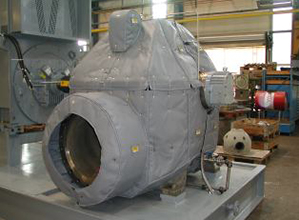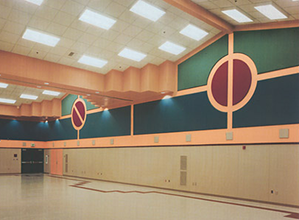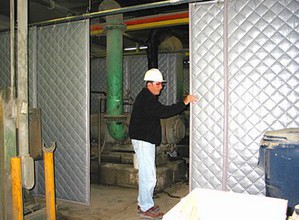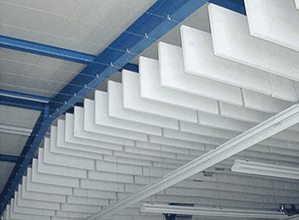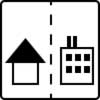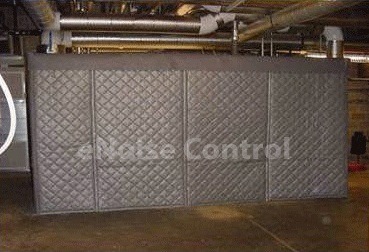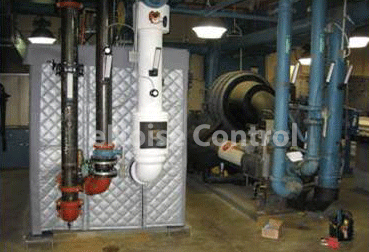Water Cooled Screw Chiller Noise
Water cooled rotary screw chillers are part of a split cooling system. The condensing coils and fans are located outdoors while the compressor, oil separator, and piping is located indoors, usually in a basement or mechanical room. The mechanical rooms are often constructed with concrete block walls, concrete floors, and metal deck ceiling. Water cooled screw chillers can be noisy, but the hard reflective surfaces and additional equipment nearby can put the sound levels near OSHA limits. In addition, the rooms adjacent and above may hear the effects of this equipment noise, making them unusable for their intended purposes. Below we list possible solutions to mitigate the noise and complaints from your chiller.
Source Noise Control
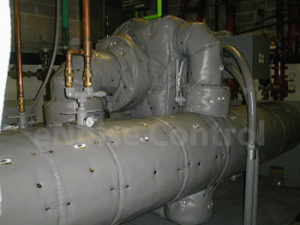 Source noise control is acoustically treating the equipment itself to reduce noise levels. In the case of water cooled screw chillers, the first option is acoustic blanket insulation. Blanked insulation is a pre-engineered thermal acoustic insulation system designed to reduce harmful noise levels and improve the surrounding work environment. Through CAD technology, it is custom fit, allowing versatility in equipment coverage. Virtually any irregular surface can be insulated and multi-piece designs are typical for most equipment applications. The blankets feature an inner and outer chemical resistant Teflon fiberglass cloth with high density fiberglass mat and barium sulfate loaded vinyl.
Source noise control is acoustically treating the equipment itself to reduce noise levels. In the case of water cooled screw chillers, the first option is acoustic blanket insulation. Blanked insulation is a pre-engineered thermal acoustic insulation system designed to reduce harmful noise levels and improve the surrounding work environment. Through CAD technology, it is custom fit, allowing versatility in equipment coverage. Virtually any irregular surface can be insulated and multi-piece designs are typical for most equipment applications. The blankets feature an inner and outer chemical resistant Teflon fiberglass cloth with high density fiberglass mat and barium sulfate loaded vinyl.
The acoustic blankets are removable and reusable. Blanket pieces install easily with minimal effort and feature a stainless steel wire-twist fastening system. No additional tools or materials are necessary for installation. Coverage usually includes the compressor housing, motor, compressor suction and discharge piping, and condenser shell. Typical sound reduction with installation of acoustic blanket insulation is 4-8 dBA.
Path – Barrier – Receiver Noise Control
This is a noise control concept where a sound barrier is installed in the path between the noise generating equipment and the person receiving the noise. Sound curtains are an effective solution for this purpose. The solution is a four-sided sound curtain enclosure with roof, supported by steel columns. The sound curtains hang on a double roller track system with hook and trolleys. This system allows panels to slide left and right behind one another for maintenance and accessibility. The enclosures also have removable roof panels, acoustical valences, and ventilation baffles on the side and roof. Clear vinyl sound barrier windows provide visual access for viewing readouts without opening the enclosure. Sound curtain enclosures typically provide noise reduction of 12-18 dBA.
Other areas to consider are open areas in the walls or ceiling that allow noise to escape from the mechanical room. Examples of these include pipe chase, seals around pipes, and ductwork openings in walls and ceilings. Inspect the doors and make sure they are suitable for blocking sound from leaving the room. If the door has gaps, install seals and a threshold sweep or an automatic door bottom seal. Also check the unit for proper vibration isolation. If vibration isolators are not present under the unit and the piping is not isolated with spring hangers and threaded rod, troublesome structure-born noise can result. Acoustical absorption can also be installed in the room to reduce reflected noise levels. Examples of acoustical absorption are acoustic baffles, curtain absorbers, and acoustic foam. These solutions can provide an additional noise reduction of 3-8 dBA.
Contact eNoise Control for help with your water cooled screw chiller noise control project.
